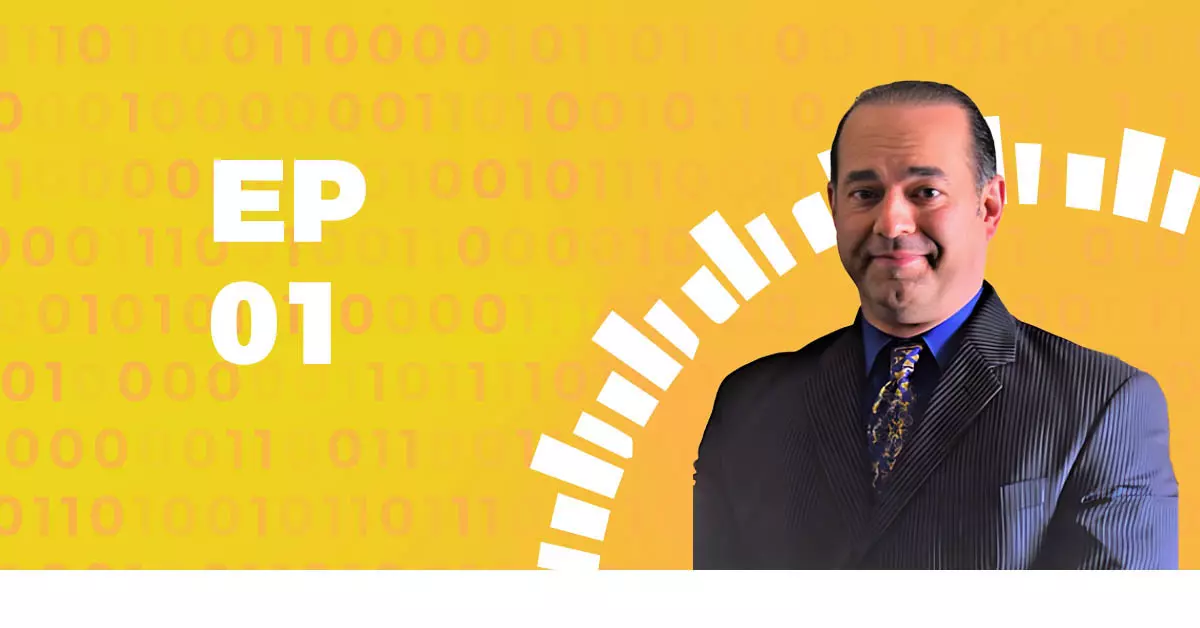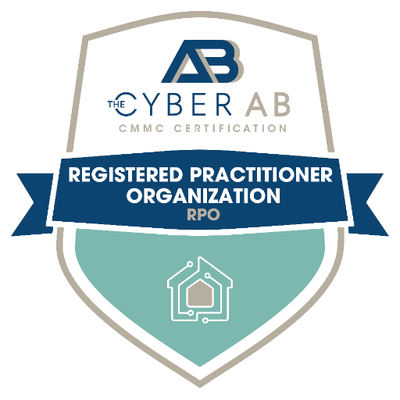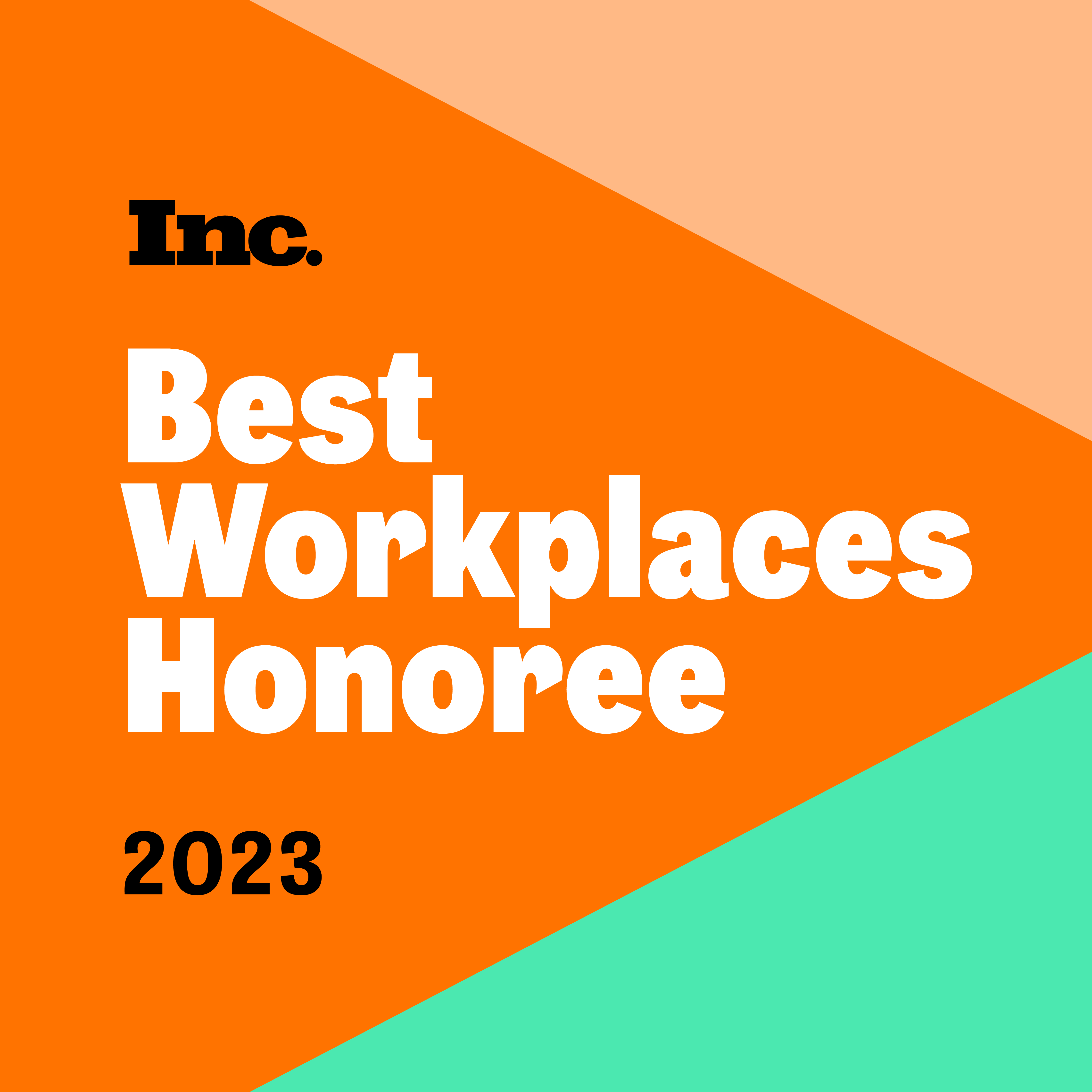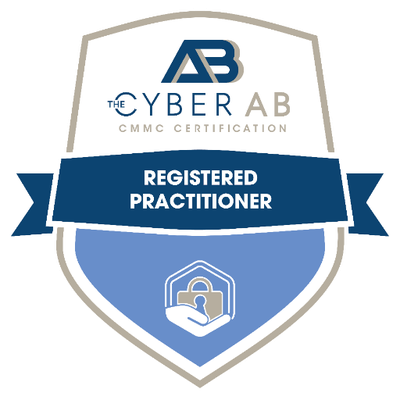Drones are the future. We’re not talking about 40-50 years from now. At this very moment, smart people are working on overdrive to make things like drone delivery possible. But that doesn’t mean there aren’t a lot of hurdles along the way. Finding solutions to these problems and getting to the market as fast as possible is what keeps Mike DiCosola up. Mike is an FAA commercial drone pilot and the CEO of Drone Industry Systems, an autonomous infrastructure solution company that will soon allow us to have a multimodal transportation option. In this episode, he talks about the state of the technology from the market, infrastructure, and security standpoints. He also states the challenges, as well as his optimistic view of humanity’s technological expansion into the airspace. Tune in and take a peek of what’s literally in the air right now and in the future!
—
Watch the episode here
Listen to the podcast here
Drone Industry Systems: Navigating The Hurdles To Drone Delivery And Other Emerging Use Cases For Drone Technology With Mike DiCosola
Welcome to the show. Our guest is the Chief Executive Officer of Drone Industry Systems, an FAA commercial drone pilot. Welcome, Mike DiCosola. How are you?
Good.
We’re going to get started here with our first question. This is what sets our tone. If cyber risk was a pizza and the frameworks are the crust, what’s the riskiest topping you’ve ever seen and what topping would you equate that to?
It’s about spoofing in what industry we’re working in because if you can have a bad actor using any type of spoof, you don’t know if it’s a real drone or not. That could be a cybersecurity risk all in itself. It is not understanding which drone is going to be operational within the scope of an approved node versus something not approved.
How is that track specifically? What exactly is being spoofed there?
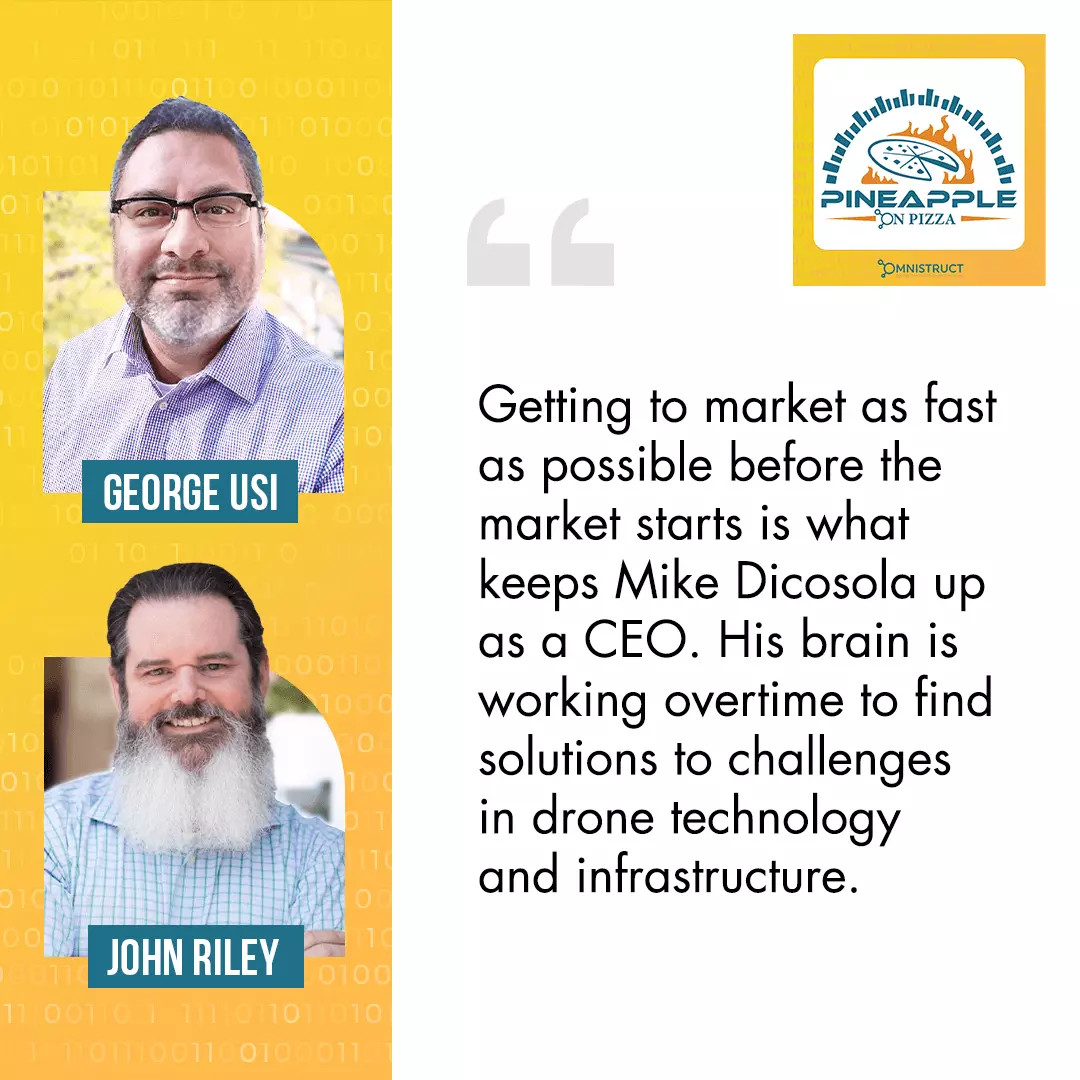
Podcast Quote 1
Let’s say that there’s a bad actor that puts in a spoof. How do we know the characteristics of that actual CPU are something we can understand the data with? Is it recognizable? We’re working with proof of reputation in order for us to have the nodes police each other. That’s the way we’re going to set it up. That way, the nodes will be able to say, “The reputation of this actual node,” which to us, everything is a node.
If it’s a CPU, it’s a node. It’s sitting on a node-centric mesh network we’re building. What are the characteristics of the action of that data? Is that out of character? Because if it is, then it can be forensically examined by vaulting it and not letting it populate within the actual blockchain. You want to be able to keep it on the blockchain, but you want to be able to not populate it within it if it’s not recognizable.
What topping would you equate that to when you’re talking about pizza?
This is a good one because I’m trying to put the analogy in my head here. If I was to say it would probably be the exposure points, how do we equate that to an actual pizza and its toppings?
I guess more or less that’s letting the pizza sit out too long. That’s good exposure. I’m going to say Turkey and pepperoni, but I don’t know if that’s right because Turkey and pepperoni are pretty good.
It’s a good point. Let’s say it’s that exposure of that pizza maybe. Don’t let somebody walk into the kitchen. One of the things that we want to look at is also the endpoints because that can be considered pepperoni. As you put each of these toppings on the network, those toppings can be considered IoT edge.
When you consider it that way, that becomes an exposed entry because now every time you have an operator, a customer, or any software access, you’re leaving yourself exposed to entries that are vulnerable. How do you avoid that? I would say consider it pepperoni. There’s a lot of it all over the place. How do we actually mitigate that risk? We need to make sure that each of those pepperonis, and let’s consider them nodes, at the edge, they’re policing each other because you need at least a cluster of them communicating together to validate the data prior to it populating.
I definitely want to eat your pizza if you’re monitoring all of that.
That’s what we’re building on. What we’re trying to do is a full stack app, so that way, it’s a node-centric mesh network and has the scalability to do that.
Where do the threat actors tend to come from when this happens? Are they already on the pizza or in the pizza shop already? Are they outside trying to get in to eat the pizza?
If you could think about it, for instance, one of the things we’re building right now is called The Smart Delivery Doorbell. It’s a data miner, and that data miner sitting at the edge. If you think about it, whoever is there can access that if they understand networking and everything, it’s not protected, or there’s no biometrics. We want to be able to create biometric access with tier-level authority, both on the operational side and also on the consumer side. You might have somebody who’s delivering a pizza, and that pizza, who was the person to actually put it in the drone? You have one exposure sitting on that network.
Biometrics might be essential to say, “Here’s the blockchain of where this genesis of data came from. This is validated data, but it’s also a validated person behind the actual entry.” Now let’s say that the operator, who’s now going to operate it, who’s the operator? What’s level of access, and did we do any biometric access for that? When it gets delivered, who is the actual receiver? How do we confirm that receiver? Those are all exposure points, and we need to take all that into consideration. Who received the product, or how do we make sure we release the product to the right person?
This is potentially a real scenario of delivering a pizza because you’re in the drone delivery business, no matter what’s being delivered. This is an actual practical application for delivering a pizza.
I was trying to pull from where I could connect this way. It’s an exact analogy.
Since we’re talking about pizza already, it’s easy to conclude the analogy with reality. You figured out a way to do both in one shot.
If you look at it, layer zero would be the crust. Layer 1 would be the sauce, and layer 2, the cheese. You want to control it from a layer zero network in order to have an understanding of what layer 1 and layer 2 are doing and to mitigate risk in that fashion. You also make it faster. You make it more scalable and interoperable. We want to make the data agnostic. Our system is being built as we speak. It’s been a while since we’ve been working on it.
The concept is to design a full-stack mobile app that allows for third-party integration of interoperable hardware, and we have agnostic software in terms of data. We want it to open a platform so that way we can bring in third-party approved drones, not just ours or third-party landing pads and charging stations. We see this as nodes because everybody needs to pull from this data to get situational awareness. That’s whether it’s weather information, telemetry, or whatnot.
That’s exciting to me, especially if there’s a pizza coming to my door. It’s an area of expertise in terms of something I’ve seen before, like interoperability in general, so that’s neat.
The pizza is going to be determined by the size. The drone is going to be dictating what the payload is and how much it can handle. You have a lot of cyber risk on all levels of this process. What if you don’t get the correct weather information, somebody hacked the weather, and you have a plan based on the weather being a certain type of information at the other end? Where is this information coming from? How many access points are there? How do we monitor this and maintain a SOC 2 or CMMC? How do we keep a layer zero situation maintained with zero trust?
In regards to your role as CEO, what keeps you up at night?
It’s getting to the market as fast as possible before the market starts. I’m creating a platform, and I made a ten-year plan. I’ve been working on this for many years, and we filed many patents over time. We’ve done a lot of R&D. We had to look at the entire process of the turnkey solution. Not just one aspect of it, but how everything affects everything. We’re in year nine, and the FAA is about to approve. We’re hoping this 2023, beyond visual line of sight at night vision. To me, I’m still buying time because they’re still waiting for these last approvals to be able to do fleet delivery and get the proper waivers in to deliver. We’re right on time for what we’re trying to achieve within the timeframe that is allocated by the FAA.
[bctt tweet=”Get to the market as fast as possible before the market starts.” via=”no”]They still got to get those congressional rules approved on those final aspects. For us, these cyber is everything because it’s not on the actual network system. It’s also on the mobile app. We want to be able to accept crypto. We’re working on our own actual digital wallet that will accept crypto as payment for delivery. That means we’re going to need biometrics for accessibility on that.
We want to make this a real UI/UX experience that has all the features necessary but keeps the customer within its environment while still allowing the operator and the vendor. It could be a restaurant or a retailer. It keeps them in their environment because we’re introducing new exposures every time we bring them in. These are the things we’re trying to pay attention to.
You brought up the FAA. Do you have any other big challenges when it comes to meeting regulatory requirements?
Clearly, we’re going to have zero trust if we do any DoD work. Once we start getting into those contracts, they’re going to require those levels of requirements. You still have localization type. What are the municipality rules? What are the state and federal rules? How do you marry them together? These are going to be all issues that are coming, but there’s a lot of support within the FAA and the associations that have gotten together to make this a reality.
These issues are going everywhere from what’s the noise mitigation of hearing a drone fly by to how high you can go and if you’re mixing in air national airspace with other different types of aviation. All these different things come into play. We’re waiting for some of this stuff to go through without being too premature in moving forward. They’re doing a great job. The industry at large is progressive in trying to make this a reality.
I definitely look forward to it. I can think of 100 things in different ways, shapes, forms, and regulatory. Clearly, you got to know where the drone is going. All of a sudden, you’re dealing with the personally identifiable information of a customer during delivery if it’s B2C. Believe me, I could think of a lot more, but you must not sleep at all.
I really don’t sleep much. It’s one of those thinking things, but I enjoy it because it’s like, “What’s the problem? What’s the solution?” You already touched base on a few of those things, like privacy laws and flying over somebody’s privacy in their home. How is that going to be affected? Will somebody not want that? We’re making a white paper where we’re creating a utility token that’s going to allow for crypto rewards for your data. Rather than taking your data from you, you can participate in the metadata you wish to use.
That data can be used in translation maybe for weather and other transportation companies can see what that weather’s like. You’re participating in weather safety, but you’re getting crypto rewards to apply towards, let’s say, your favorite vendor food or delivery cost. We’re trying to make a system that is frictionless where the privacy issue becomes an incentive to where you own the data, how you distribute that data is at your will, and participating in it is only going to enhance safety, security, and sustainability.
That’s the blockchain. I can see that. There’s one coin in particular called Jasmy in Japan that’s regulated. What they’re doing is the IoT is always in Japan. That makes me think of that when you talk about blockchain and the delivery of privacy data. That’s Japan, and this is coins, obviously. There are regulation issues. I wonder about that.
You brought us a whole new level of regulations because now it’s like, “Are you an accredited investor? Are you not accredited? Who’s going to invest in that crypto? Where exactly did you set it up internationally versus locally? What’s domestically authorized?” It becomes a nightmare, but the whole goal is you have to bifurcate everything into different categories. You have to make those rules apply to where it belongs, and then somehow create the actual nexus between them.
That’s why it’s such a long process. It’s a big process. There are a lot of companies tackling this. They’re working very hard, and we’re one of them. Our goal in particular, is to make sure that we were ahead of the game in thinking about. For us, we have three goals, safety, security, and sustainability. In aviation, safety is always paramount, but without security, safety has no value. You can sit there and say, “Safety is number one, but what’s the security behind it? How do we protect this?”
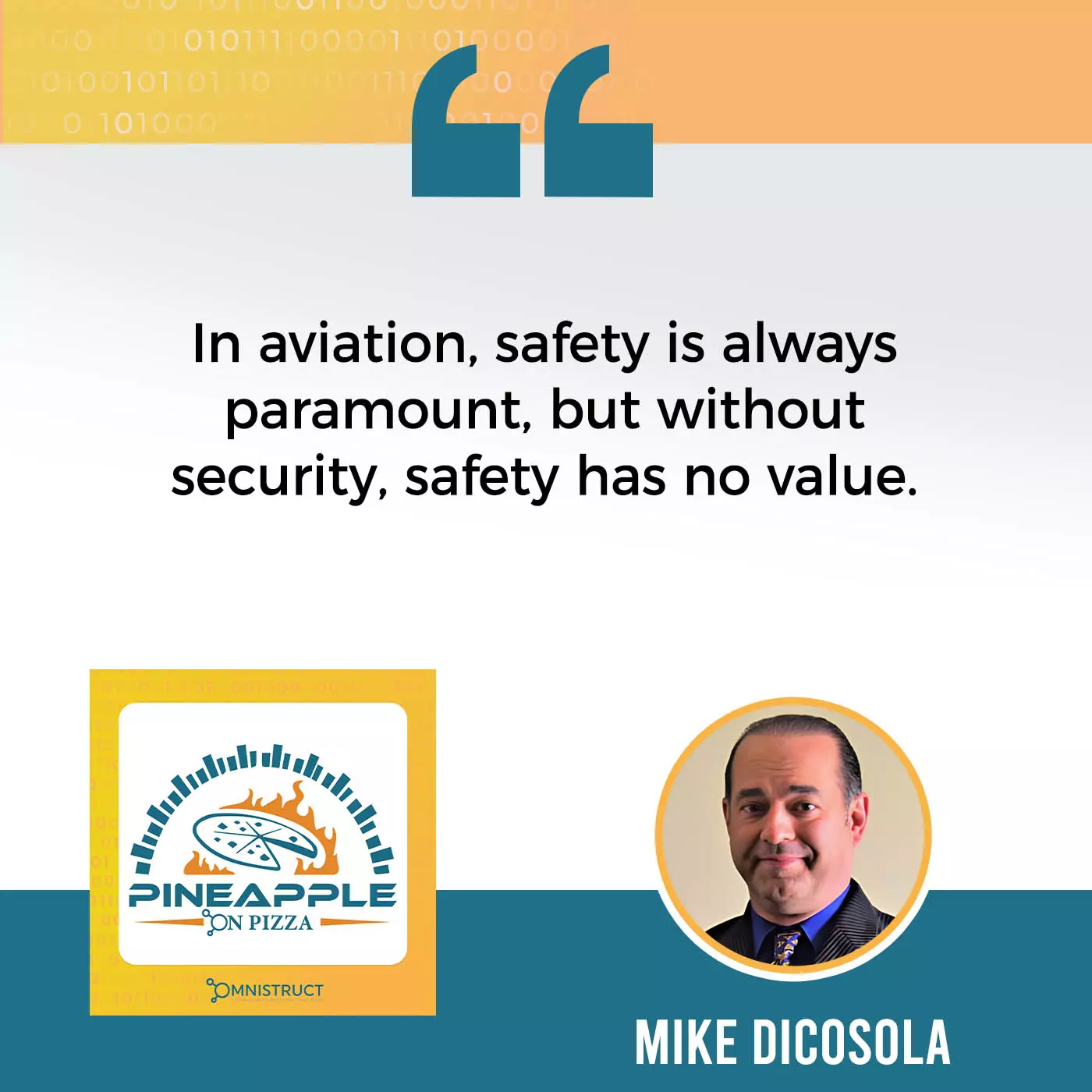
Mike Dicosola Quote
That’s where a lot of the issues of everybody talking. Safety also becomes like, “If you have a loss link in the middle of a 5G transfer, you’re using one carrier, and then there might be some weak transition over to another carrier. Now, what happens?” It’s those types of safeties. One of the things we did is the Drone Industry Systems created an infrastructure solution. We’re repurposing rooftops.
That’s one of the IPs we filed. We can take a restaurant or a retailer and change the rooftop where we basically modify the rooftop. We repurpose it into a drone airport, now creating an infrastructure where we can put weather sensors and charging stations there. The more of those you have, the more safety you have because if you did have a loss link, where’s the nearest home base? How can that drone go land back somewhere closest to it? How do you stay up all night if you’re thinking about all this stuff? You’re like, “What happens to this and that?”
I can relate to that. That idea of not connecting over from carrier to carrier, but it’s what we call delay tolerance networking. All of a sudden, you have a delay, you store in forward, and you program to go automatically to some rooftop. It’s something I had to deal with years ago when we were looking at first responder interoperability of radios. This is on a massive scale. There are all kinds of challenges here that a lot of different industries are working on. I imagine not just you, but this is all over the world. That’s exciting stuff.
If you think about it, we’re taking a look at this as we have certain types of networks and connectivity. How do we make it? How do we let drones frog leap between airports? An airport has what we call a hub and spoke environment. The hub being an international airport, and the spoke being a classy airspace small little airport mom-and-pop, so you have a hub and spoke environment. That’s the same type of environment we could put on top of rooftops, leaving the drones away from the public, but sitting where it’s accessible.
It’s still behind a parapet wall, but the bigger the rooftop, the bigger the airport and the more versatility you have. You might have a bifurcation of a defibrillator drone, a first responder drone, an amber alert drone, or a traffic drone, and then you still have your delivery drone. You can turn around and make this roof into different categories. How many different networks is that? Can you frequency-hop? There are frequencies, but there are also pay-as-you-go frequencies. Maybe we do an antenna for that frequency hops, and that makes things safer. It grabs the first one. It makes it less expensive. You got to think about all this stuff.
I can imagine. You’ve definitely got my brain working overtime on ways to possibly solve it.
I want to see your whiteboard. That’s what I’m looking for.
It gets a little crazy.
What do you see as the future? Obviously, you see drones are the future. You’ve pulled us some great things to think about it. Is there anything special that we should know and our audience should know about drone delivery and security? You’ve already covered a lot of it, but anything else you’d like to add?
The most important is going to be the safety that we discussed, but that security is what we’re talking about between the three of us here. That security is everything. In order for this to succeed, there has to be a system in place where you can find the genesis of that data. That way, you understand who had access to it and where did it derive from, but you can also reward. It’s not just the bad data, but it’s also good data. By knowing on the blockchain where that data came from, you can reward those people for participating in that data and allow others to participate with that information. For us, drones are anything that’s autonomous and takes humans out of the loop.
If you think about a ground robot, an autonomous car, or a quadcopter, that’s all autonomous. It’s all the humans out of the loop, but you’re still using the fleet to manage that. If you’re going to be using a fleet to manage that, you have to be able to have some trust factors at all these endpoints. How do we do that? This is where the FAA is working on making identifiers on planes. The drones are going to have identifiers. Now, if you shot down a drone, you shot down a federally protected one. It’s like knocking down an airplane. They’re smart in the way they’re looking at this. They’re trying to make sure they’re locking down all the solutions that need to be addressed.
Tell us, Mike, what events do you go to to learn more about this?
For myself, I try to go to IoT events and drone events. There are advanced mobility events, which are the actual events where mobility becomes a thing for autonomy. We try to go to those. In the real estate market, we’re also looking at doing improvements to the roof. Part of our autonomous infrastructure is creating that nexus between the digital wallet and the operating customer use. That full-stack app is connected to where these drone airports are going to be. All that has got to come into play.
“We got to pick an ideal roof. Which roof would you pick?” Does that cross your mind?
It’s a very good question. The perfect roof, believe it or not, is a strip mall with a bunch of restaurants, retailers, or convenience stores. Think about it. Usually, a strip mall owner or management will have one end unit that you can do a drive-through on. If you can go to the tenants and say, “What if I made your rooftop capable of all of you using it and leveling the playing field, and we can allow everybody to use the drone rooftop?” Now everybody is having an end cap, but you’re providing it to all the tenants. Whether it’s a lab test, a pizza, a retail product, fast food, or simply dog food, the goal is to have as much diversity as possible.
I believe it. The thing that comes to my mind is McDonald’s because they own the ground. They’re the landlord. It’s at scale. I’ve tried to get on rooftops before, and sometimes the landlord won’t let you up there. It depends on the property it is. The immense number of opportunities is really impressive.
Our three points are the Smart Delivery Doorbell Data Miner and the Smart Drone Landing Pad Charging Station. If you picture that mall we’re talking about, that landing pad will be sitting right in front of the door. That way, anybody can load the food up, but the drone is sitting on top, and it comes down when it’s hail.
If you cut what we do for last-mile logistics, we’re less than load because we’re not waiting on the hailing of something to come to us. We’re helping the customer be in control of their own transportation so they can sit there now and say, “Hail the drone, the drone comes down, they load it, and it goes,” so you’re not waiting for it to come to you.
Maybe a discount if you have the landing pad, right?
Yes. What we’re doing is we’re looking to do to create datapreneurs so they’ll be able to buy these landing pads and doorbells, and they can get in the business of providing data for crypto. This is where we’re going with that.
Mike, are there any books you would recommend?
Not necessarily.
Sometimes, there are great recommendations so we always like to ask. What excites you about the future? What are you looking forward to? You’ve excited me about the future on this, but where do you see things in 20 or 50 years?
There’s what we call VTOL, so Vertical Take-off and Landing vehicles. This is something that people will say, “Flying cars. That’s what that really is. There is no way flying cars are going to be in my lifetime.” I’ve got news for you. It’s going to be here by 2025. It’s going to be legal and already in the system. They’re working hard on this. NASA, FAA, and there are hundreds of companies that are put into this right now, this industry at large. You would think drones are one thing, but we’re talking about flying taxis and flying cars. This is real. You would think this is going to be 50 years from now, but it’s not. Security is going to be a whole new level of importance. It’s going to have such significant importance.
I remember hearing a story when the idea of drone delivery first started in San Francisco. The real estate market was trying to figure out how to license the airspace above the buildings in San Francisco. Whether they got there or not, how far it got or it became a reality is another story. Say there are all these markets expanding. We’ve gone underground, and we’re already on the surface with cars. The next field of expansion is the air for sure.
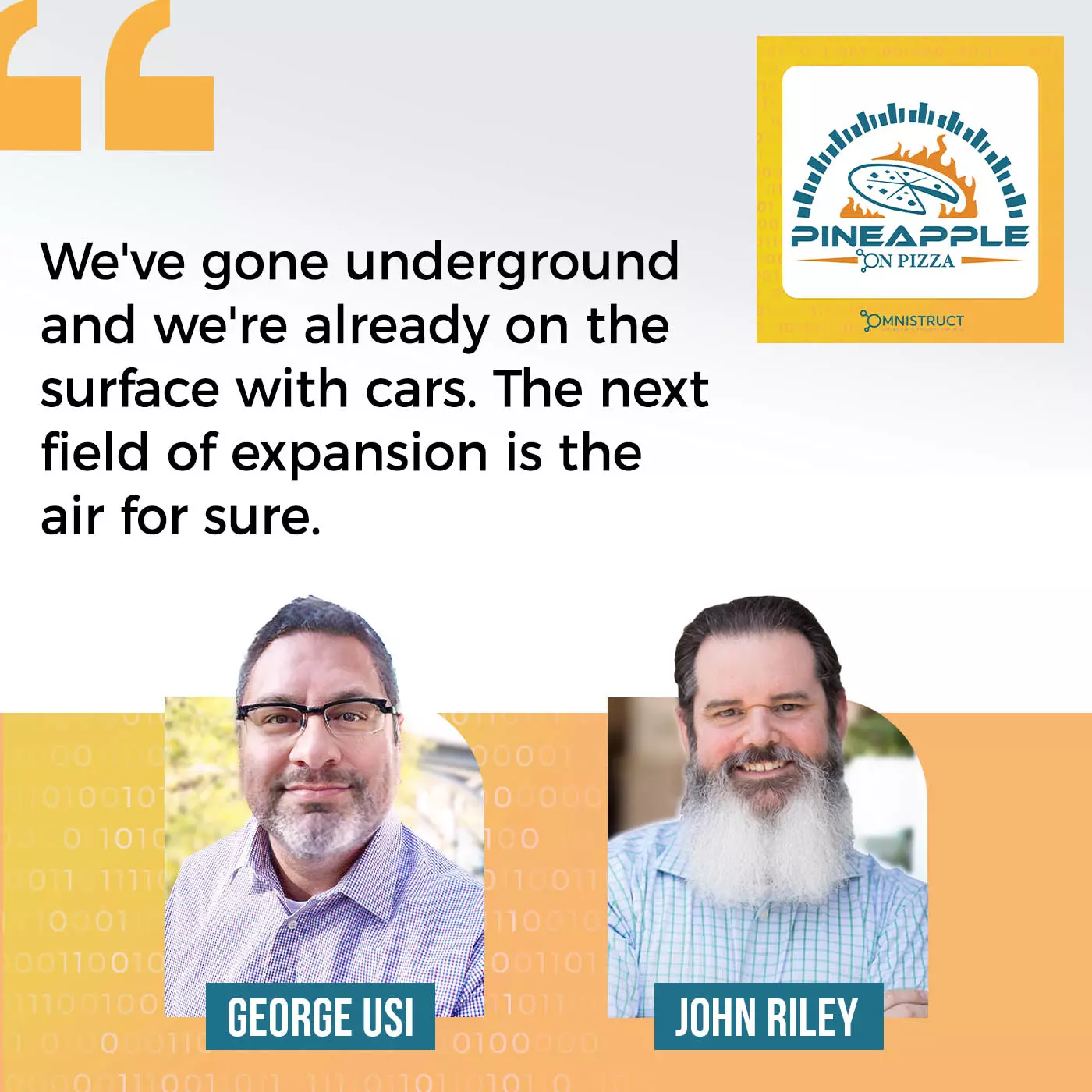
Podcast Quote 2
Believe it or not, in general, without knowing what the weather is at the departure en route or arrival stations, you have no real true situational awareness. That’s going to be another level of importance.
Mike, tell us a little bit more about yourself. Where did you start out? How did you get here? How does somebody become the drone FAA expert that you are?
I like to say that you’re never an expert, in my opinion. I’m always a student. From a standpoint of how I got here, my 0s and 1s started when I owned a factory. I was doing CD and DVD manufacturing. That’s where I started getting into the glass masters, the duplication replication, and polycarbonate. We started getting into that system and started getting into the executable files for different industries. From there, I started going into networking. The concepts were built from a manufacturing standpoint of making CDs that were shaped like business cards. That was one of our inventions, but it was more for shapes rather than business card ones.
From there, it’s been a passion for technology. I went back to school to get a double degree in Aviation Transportation Management and Unmanned Systems for Marine, Ground, and Air in order to make sure that the patents I filed on the stuff I told you about made sense with national airspace. I’m a senior’s senior right now. I’m in their Master’s program. My education will continue. I will always continue to have my education because it’s important to me that I’m staying cutting edge and I’m understanding so many different levels, like batteries and the actual physics of things and how things work.
You have to pay attention to the all-encompassing process. I’ve evolved from manufacturing and then I’ve worked my way into the actual aviation side and the robotics side. That’s how the connection wound up happening. I have a real estate development company. The actual going onto the roof part is not foreign to us. The whole concept of taking these three components is what made me come up with the idea.
Are you doing your own blockchain, or are you using somebody else’s blockchain?
Now, we’re building other blockchains. There’s a technology that we’re waiting on that will allow for all the stuff we discussed to be mainstream because we need scalability, interoperability, and also make sure that the latency is at par with the actual growth of the data that we feel is going to be necessary. There’s going to be too much data being pumped through there. We know what system network we’re waiting for, but we’re waiting for the SDKs to come out, and we’re building off of that.
You have your plate full is what I’m hearing. It’s like Thanksgiving every day and learning for you.
As I said, I’m a student for life, and I will always be so I can appreciate everybody’s field and interests. I’m always going to be learning. That’s where it came from. Those three components are real estate with the development side, manufacturing, and aviation. You didn’t have to go to school for aviation, but you had to go to school for aviation. The same thing applies to the robotics side. You got to understand the robotics side of it.
Why don’t you tell us a little bit about what your company does? You’re CEO of Drone Industry Systems Corp, and you’ve talked about it, but give us the 30-second pitch. Tell us specifically what you do and what you be looking for.
Drone Industry Systems Corp is an autonomous infrastructure solution company. When we say autonomous infrastructure, the word drone is synonymous to us with anything without the human in the loop. We’re anticipating what will happen. We’re creating the first mobile app that will allow you to have a multimodal transportation option. To us, that means, do you want the ground robot? Would you like the drone, or would you like the autonomous car? As this starts to come into the system, there are the manual operators that we’re building into the system, but eventually, this stuff is going to be autonomous.
When an operator of a pizza place, for example, turns around and says, “I want a ground robot, but I also want two drones on my roof. By the way, that new autonomous Tesla, I’d like to have one of those delivered,” whatever that may be, we know that this is coming. We’re building a full-stack mobile app to allow for that. Let’s say that the weather is conducive for flight on a drone and you order something as a consumer like you would on Uber. We want to be able to say, “This vendor has these three choices of shipping. One is going to get there in 2 minutes, and one is getting there in 4. What’s the convenience fee you want to pay and go from there?”
What it is is a platform. We’re creating the nexus between the physical and digital by repurposing your rooftop into a drone airport, giving you the power back. The actual retailers and restaurants, we’re giving them back the power. We’re saying, “This is your money. Why take 30% of your money and give it to somebody else? Why don’t we charge for delivery and that’s it?” If you want to market on the actual app, we can get you to market on it. That’s what Drone Industry Systems is doing. It’s a full-stack mobile app and the nexus between the digital and the physical.
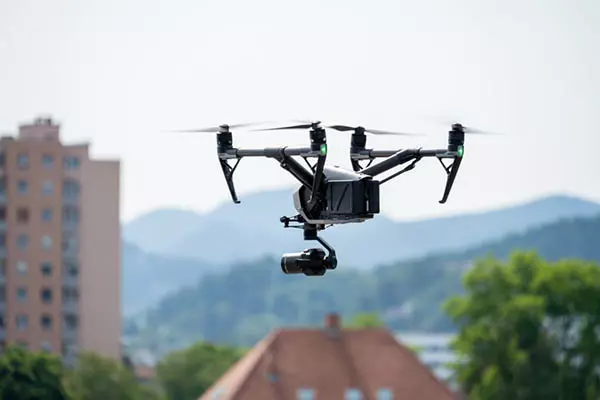
Drone Delivery
Here’s our introspection question, which is, if you could go back in time and give your younger self advice, what would that be?
I would say surround yourself with everybody that will know more than you so you don’t know anything compared to what they are and have that as your crew for good.
One of the best things that ever happened to me was the mentors.
If you can fill your life with everybody that knows more than you, then you’re great. You’re going to keep learning. Again, I’m a student.
When you’re not studying and when you’re out doing these other things, what other hobbies do you like to do? Do you have time for anything else?
I don’t get the luxury of playing as much as I would love to play, but I do love to play pool. It used to be when you played somebody else. Through time, you play the game, and you realize that game is you playing against yourself. If you play that game where you’re playing against yourself, you learn a lot more about that game than if you’re playing somebody else.
I always say I prefer a good game of billiards over a game of golf.
In a game of nine balls, I could sit there for a while. I won’t have any competition except myself.
Where can people find you, Mike?
Thank you. You can reach us at DroneIndustrySystems.io. You’ll be able to see the first drone MP4 NFTs that are digital art right now. We’ve already put up a marketplace, so we’re the first in the drone industry to make a marketplace for this. Now, it’s digital art, but once the actual doorbells are made and the landing pads are data miners, they will have the right to purchase the NFTs by exchange, and those NFTs will become keys for their crypto rewards.
You’re also on LinkedIn, is that correct?
Yes, I am on LinkedIn as well. It’s Mike DiCosola.
Mike, I appreciate your time. It’s been very informative. We appreciate the learning that we’ve done on this one. For our audience, thank you for reading. Suppose you’ve learned something or laughed, tell someone about this show. Again, Mike, thank you.
John, George, thank you. Omnistruct, thank you.
This has been another great episode. See you next time.
Important Links
About Mike DiCosola

Mike DiCosola
Location: Buffalo Grove, Illinois
Chief Executive Officer of Drone Industry Systems
His interest and focus is in National Air Space Infrastructure for the UAS/Drone Delivery and Services industry.
FAA Commercial Drone Pilot
(Education)
*Lewis University
Aviation Flight Management & Unmanned Aircraft Systems
Activities and societies: Alpha Phi Sigma-Criminal Justice Honor Society
National Society of Leadership and Success (NSLS)
(Present)
*CEO of Drone Industry System Corp. Drone Industry System Corp are the inventors of the first Smart Drone Rooftop and Ground Airport, Smart Drone Mailbox Landing Pads, and Smart Drone-in-a-Box System for Drone Delivery Logistic Services. Our Smart Drone Airport-in-a-Box allows for the customization of your drone delivery needs.

